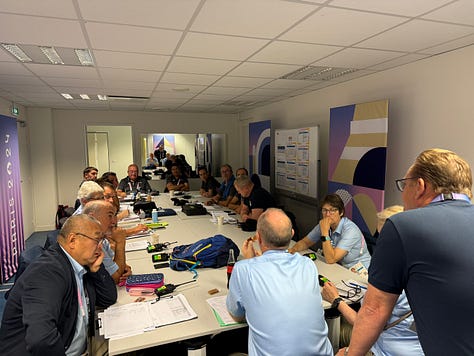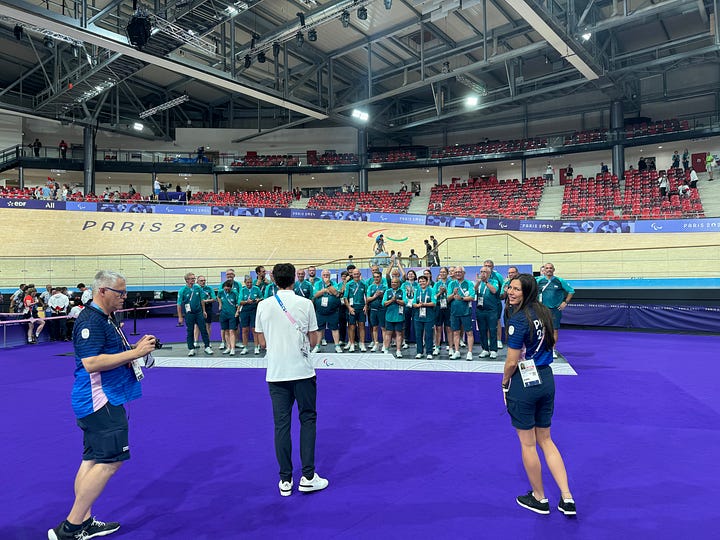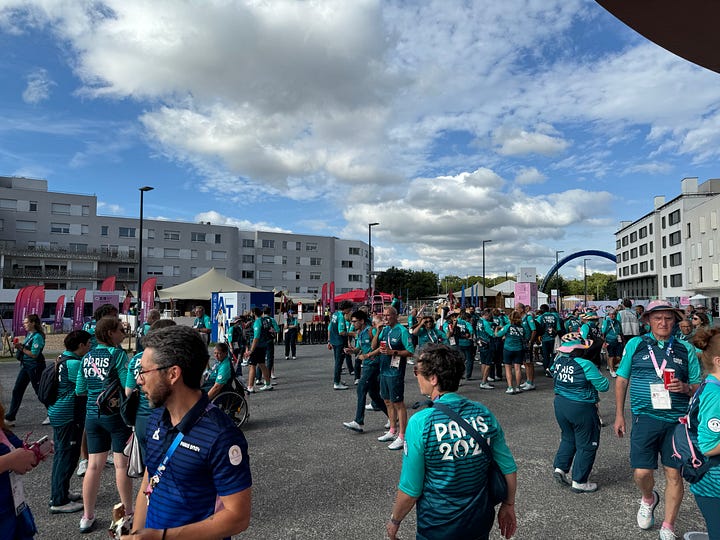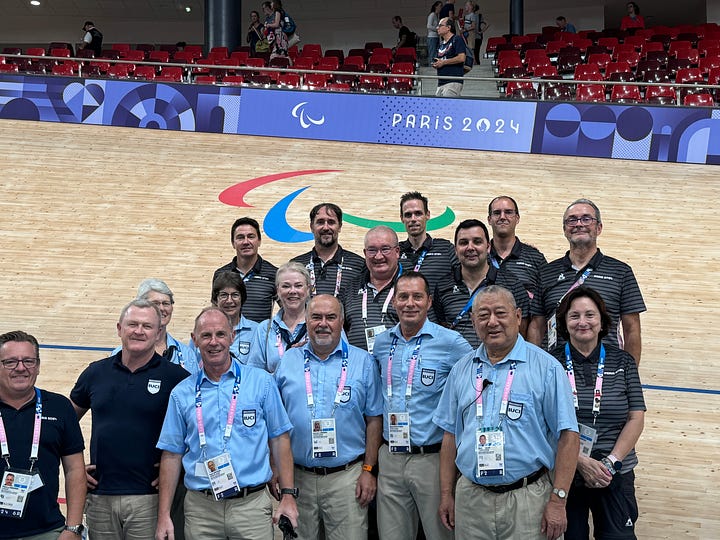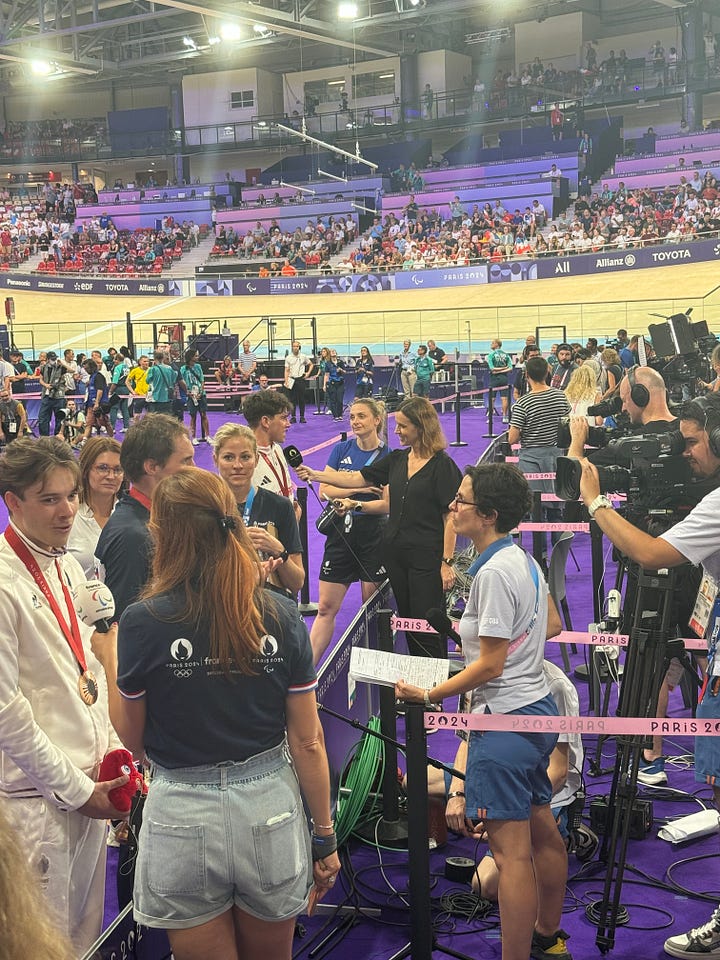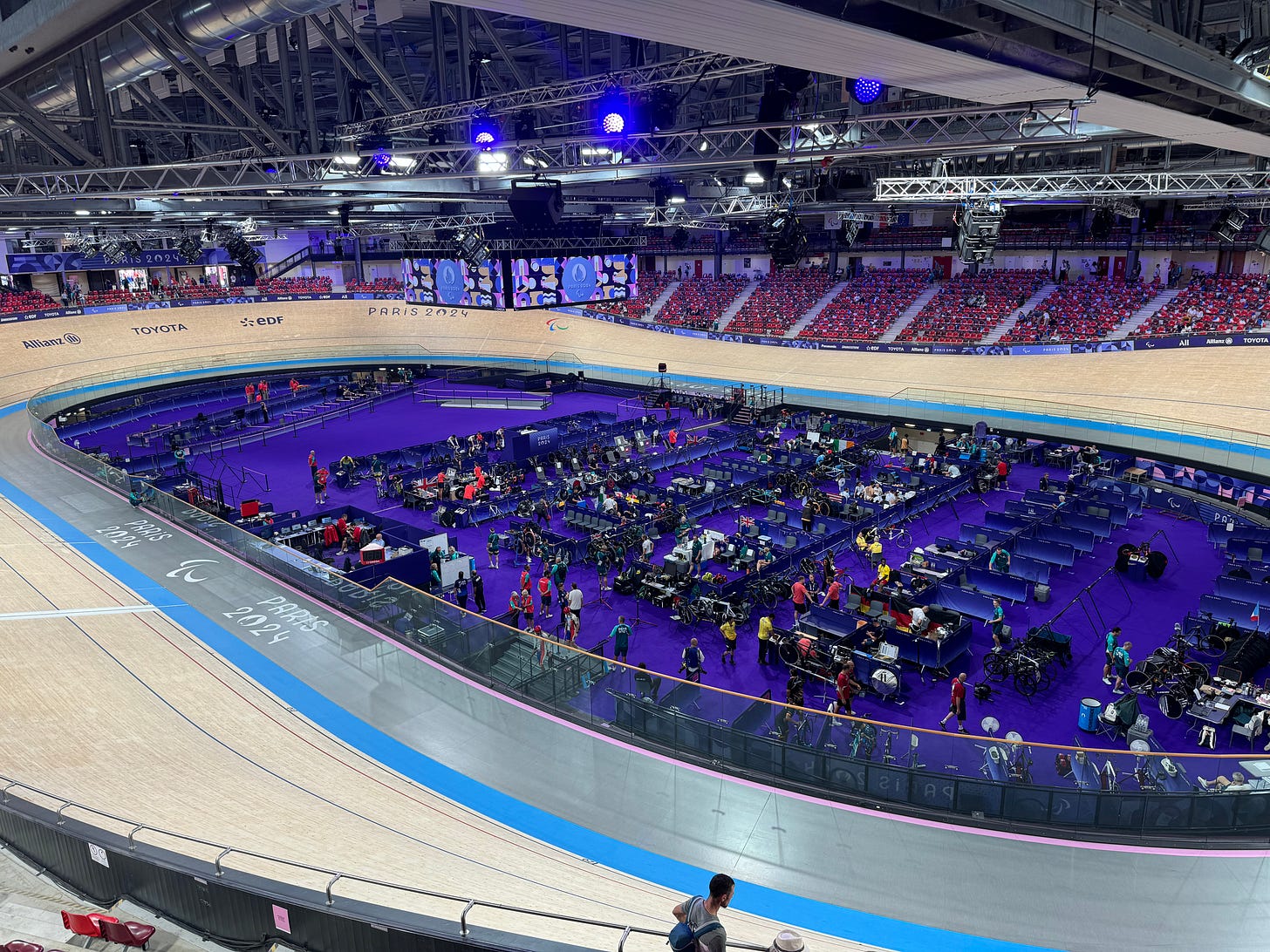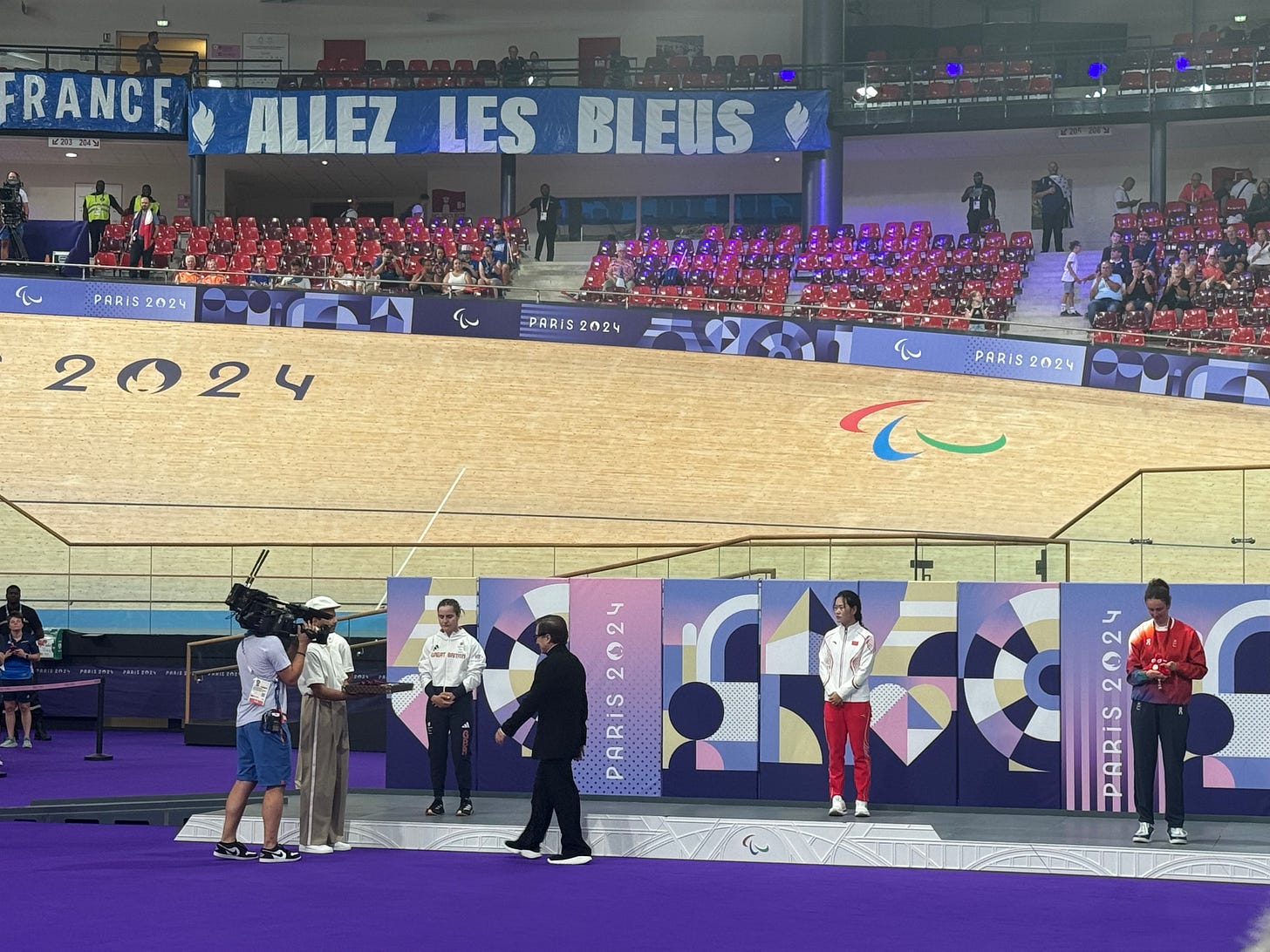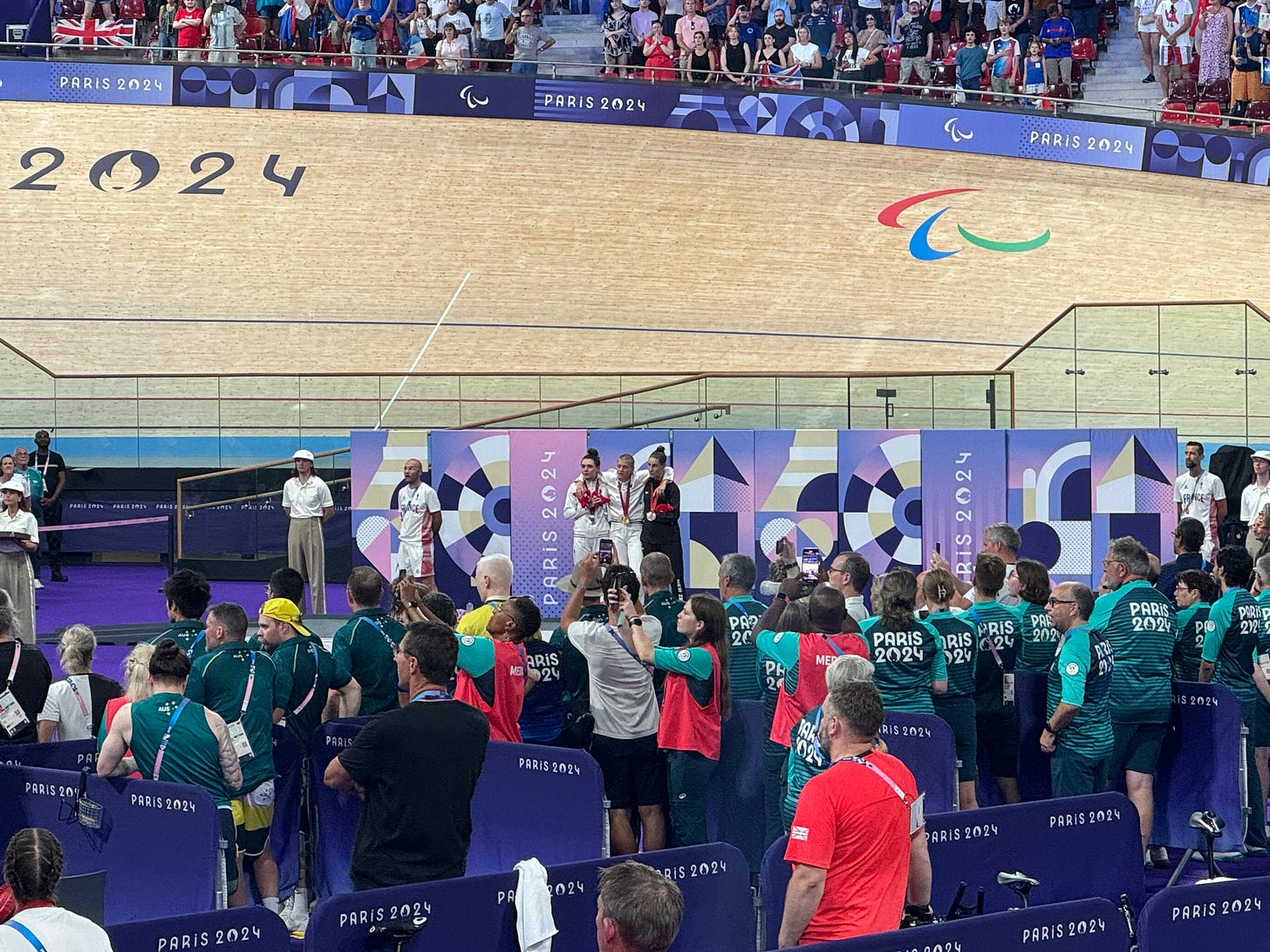With the closing ceremony over, it is time to get into the reason everyone is in Paris: sport, and it begins immediately. What was not mentioned before is that many athletes choose to skip the opening ceremony because of how quickly the sport starts and how stressful and tiring the ceremony can be. This can be especially taxing for athletes with certain impairments. To possibly ruin some of the magic, I know at least one nation only sent team staff, aside from its athlete flag bearers, to walk in the opening ceremony. The focus was on performance rather than celebration to the extreme.
The first morning of Paralympic sport starts with multiple events kicking off as early as 8:00 a.m. in some locations. For para-cycling, we do not begin until 12:00, but the day will be fast and furious, finishing with the first awarded medal of the Paralympic Games. As officials, we arrive about three hours before the competition starts and inspect the venue and track for safety. The Paris 2024 team is already on-site to open the venue and begin all services for the day. Teams for media, broadcast, ceremonies, VIP, ticketing, fan services, concessions, and more are on-site and ready for the first day of full operations. The team staff and mechanics are preparing the bikes for the athletes to arrive.
The venue itself is the national velodrome of France, one of the best track cycling venues in the world. The conversion for the games was relatively easy, with some refurbishment and a few temporary facilities added, such as security, VIP, and more team storage options. The inside of the venue is branded with Paris 2024 to match the theme of the Games, and the infield is topped with a purple carpet that makes the whole venue pop in person, especially on TV.
As racing approaches, training and warm-up conclude, a final venue check happens, and then the show starts. But I don’t mean sport yet—there’s an actual show about to take place for the teams and the 4,000 people inside the velodrome. The lights go down, music plays, images of cyclists are projected onto the track, and then, out of nowhere, a DJ on a tower appears, and a disco ball drops from the ceiling. It's a quick change of tone, but it certainly grabs the attention of anyone not in their seats yet. In addition to the show, each session of the Olympics had a famous person open the event, and it's no different here. This is called the "Trois Coups," the call to attention as the sport is about to start. It’s time to race for real!
At the Paralympic Games, track cycling includes three events: the individual pursuit, the 1km or 500m time trial, and the team sprint. All have various qualification rounds, followed by final rounds that will award 17 medals total over four days, including four on day one. The fans are in their seats, and it has been confirmed that there are four days of sellouts, with extra seats even being created to meet the high demand.
The first race is the women’s C4/5 500m Time Trial, where each athlete sets their fastest 500m time. The top six athletes qualify for the finals, where they give one more 500m effort for the medals. Everything starts as expected, with riders setting their times, until the first French rider enters the gates. Marie Patouillet walks onto the track, and the crowd goes wild. She is the face of Dior and LVMH for the Paris Games and has grown in popularity leading up to the Games. She sets the time to beat, with only a few riders remaining in qualification, but you can already sense something special is about to happen.
As the first race is wrapping up, the crowd does not get quieter, and the track heats up. The final qualifier for the Netherlands breaks the world record. The next race hits the track, and more of the same happens—records, records, and more records every day. In total, there were 15 World Records and 2 Paralympic Records across just 17 medal events. The fans there pushed everyone to give more than they knew they could. If you didn’t believe in the power of atmosphere before, this was proof that fans can push any athlete beyond their limits.
As day one finishes, the preparation for medal ceremonies gets into gear. The team is ready for its moment, and it is special. As mentioned earlier, these ceremonies are the first of the Games, meaning some of the most important people in sport will be present. Ceremony one features IPC President Andrew Parsons and Paris 2024 President Tony Estanguet. Ceremony two includes IOC President Thomas Bach and the UCI President. The third ceremony has a surprise guest: movie star Jackie Chan, who presents the prizes. Even at over 70 years old, he still looks in great shape. The athletes are thrilled to receive medals from him, especially the gold-winning Chinese athlete. You could see the excitement from both the athlete and Jackie as he handed over the medal. It was the perfect ending to an almost perfect day and a fantastic start to the Paralympics.
As the competition continues over the next three days, the highlights keep coming. While the days aren’t always filled with VIPs, the energy remains electric. Tony must have sensed this because he came to the velodrome for three of the four days of competition, even though he has 1,000s of staff and 20 other venues in operation. It's a recognition of what is happening in track cycling, especially for French athletes. Some of my other memorable moments include:
• Fan Flags – Every day, a section was set up for French supporters in the stands. On the third day of competition, with many French medal contenders, the LOC took it to the next level. Every seat in the stadium had a French flag as a gift, along with signs and giant heads of the top athletes. From a safety perspective, it was a concern as flags occasionally ended up on the track, but it undeniably added to the atmosphere and energy.
• Men’s B 1000m – This event was especially dramatic, featuring some of the biggest names, all specializing in speed events. It was their one chance at the Games to shine. At the UCI Para-cycling Track World Championships in Rio earlier this year, I saw one of the most disappointing silver medal reactions after this event. The British tandem of James Ball and Stephen Lloyd, despite finishing second in the world, thought they might be left at home because Britain had also taken first place. Fortunately for them, the British team took a chance and brought both sprint tandems to the Games. It paid off, as Ball and Lloyd had two fantastic runs and secured a gold medal. It was a great display of team leadership recognizing the value of these two athletes, and GBR ended up leading the track medal table.
• Media presence – From day one, media numbers exceeded expectations, especially from nations that had never attended UCI events before. It was another proud moment for me, as the media manager noted that the mixed zone saw more action than many days at the Olympics. This is a huge step forward for the growth of the sport.
As the last day of competition approached, one of the marquee events was the women’s C5 Individual Pursuit. It was one of the deepest fields, featuring two French athletes: Marie Patouillet, who had announced that the Paralympics would be her final competition, and 19-year-old Heidi Gaugain, competing in her first Paralympics. Nicole Murray from New Zealand, the 2023 IPC Female Athlete of the Year, was also in the race. As the heats unfolded, anticipation grew. Marie and Nicole set times that guaranteed them spots in the medal rounds, but the question was what color they would ride for, with two riders left. Heidi was incredibly strong and finished with the fastest time, but her Italian counterpart couldn’t keep pace, setting up an all-French final. The crowd went wild, knowing that a French gold-silver finish was guaranteed.
In the final, Heidi's youth and ambition gave her an early lead in the 3000m race. However, as the crowd's energy grew, it seemed to fuel Marie, who slowly began to claw back. With 500m left, it became clear that this would be Marie’s gold medal, and the passing of the torch would wait for another day. Marie’s effort captured her first Paralympic Gold, and I felt the energy of the entire country. The pressure must have been immense for her, with joy quickly replaced by exhaustion. When it came time for the ceremony, only 20 minutes later, she had no energy left. After walking onto the stage, she fell to her knees, unable to stand. Her fellow athletes stepped in to support her as “La Marseillaise” played one final time in the velodrome, full of emotion. It was a moment where everyone felt every emotion possible after four incredible days of competition.
As track cycling wraps up and people leave, the Paris 2024 team is already tearing down the venue. The Games are over for this competition site, and the team that has been working here for months, even years, is winding down. Surplus ice cream from the concessions is distributed to all volunteers and staff, and as the last few people leave, they are serenaded by groups of volunteers thanking them for bringing the energy one more day. The volunteers receive the same thanks from the fans, as both groups were excellent throughout the competition.
I will remember the energy and the crowds for the rest of my life. The sound in the velodrome was unlike anything ever experienced before, even better than the Olympics, as confirmed by everyone I spoke to who attended both. However, para-cycling isn't over yet—road competition begins in just three days. It's a quick transition for us. The balance has been hard, as while track competition is happening, I am still managing the needs of the road events and the office back home, ensuring everything is ready for the upcoming days and weeks. The Paralympic road cycling venue is already in full swing, and the teams and I will arrive in the morning to reset and prepare for two more days of setup and four days of amazing competition.

